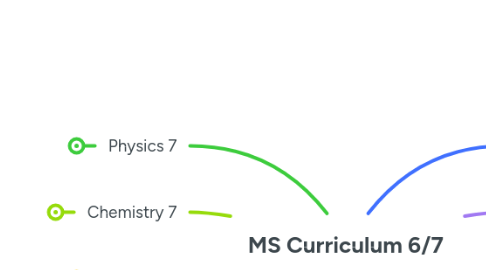
1. Physics 7
1.1. Quantities and measurement
1.1.1. Continuing from previous year
1.1.2. Measureing volume
1.1.3. Calculating speed
1.1.4. Simple numericals, without SI units
1.2. Force and Pressure
1.2.1. Motion: define, identify objects in rest and in motion, describe uniform, non-uniform motion
1.2.2. Difference between mass and weight
1.2.3. Gears: exploring with cycles and making gears
1.3. Energy
1.3.1. Define energy, express in units, types of energy
1.3.2. Relationship between work and energy; interconversion; law of conservation of energy
1.4. Light
1.4.1. Reflection; laws of reflection
1.4.2. speed of light, primary and secondary colours; where does colour come from; prisms & rainbows
1.5. Heat
1.5.1. heat as energy; units; temperature scales; effects of heat; modes of heat transfer; conductors vs insulators
1.6. Sound
1.6.1. Build: Wave
1.6.2. How is sound produced in the human body/ how do animals use sound
1.6.3. sources of sound; amplitude and frequency; jaltharang?; reflection and absorption of sound; design a sound-proof box
1.7. Electricity & Magnetism
1.7.1. Laws of magnetism; electromagnets and uses
1.7.2. Current as charge; draw simple circuits; conductors and insulators; making series and parallel circuits
2. Chemistry 7
2.1. Matter
2.1.1. Describe matter; matter has mass, takes up space; atoms and molecueles
2.1.2. Physical and chemical changes to matter; demonstrate melting, boiling, sublimation
2.1.3. Cooking to understand how heat affects matter
2.2. Elements, compounds, mixtures
2.2.1. What they are, how they are classified; classifying elements and compounds;
2.2.2. Collecting samples of solid-solid, solid-liquid, liquid-liquid mixtures from daily life
2.2.3. Separation techniques: filtration, distillation; chromatography
2.3. Atomic structure
2.3.1. atom, molecule, radical
2.3.2. significance of valency of elements and radicals; correlate valency with group number of periodic table
2.3.3. Periodic table and the logic behind it
2.4. Language of chemistry
2.4.1. chemical equations; periodic table
2.4.2. Reactions: demonstrations and cooking
2.4.3. Identify reactants, products of the reaction
2.4.4. Writing word equations
2.5. Metals & Non-Metals
2.5.1. Differentiate on basis of physical properties
2.5.2. Examine properties through activity: conducting electricity
2.5.3. uses of certain metals
2.5.4. Discussing metalloids
2.6. Air and atmosphere
2.6.1. Air is a mixture: pie chart of components
2.6.2. List the uses of oxygen, nitrigen, co2
3. Biology 7
3.1. Tissues
3.1.1. Organisation into organs
3.1.2. Plant vs animal tissues
3.1.2.1. Plant: meristematic & permanent; simple: parenchyma, collenchyma; complex: xylem, phloem
3.1.2.2. Animal: epithelial; connective; blood; bone; muscle; nerve
3.2. Classification
3.2.1. Why classify?
3.2.2. 5 kingdoms, characteristics, examples
3.2.2.1. Animalia: vertebrata and invertebrata
3.3. Plant life
3.3.1. Photosynthesis: see, demonstrate, basic chemical word reaction
3.3.2. respiration: stomata and chloroplasts
3.4. Human body
3.4.1. Excretory
3.4.2. Nervous system
3.5. Health and Hygiene
4. Math 7
5. Physics 6
5.1. Matter: solids, liquids and gases
5.1.1. Texture and volume
5.1.2. Qual Obs: distinguish between s,l,g
5.2. Quantities and measurements
5.2.1. Define: length, mass, time, temperature
5.2.2. Measure, convert
5.2.3. Correct methods of measurement
5.3. Force and Friction
5.3.1. Push, pull, friction, change direction of motion
5.4. Energy
5.4.1. What is energy
5.4.2. Simple machines - lever, pulley, wheel, inclined plane, wedge, screw
5.4.3. Mechanical advantage & calculations
5.5. Light
5.5.1. Travels in straight lines, reflection, refraction
5.5.2. BUILD: Pinhole camera, Human eye
5.5.3. Shadow
5.5.3.1. BUILD: eclipse, shadow puppet play
5.6. Magnetism
5.6.1. Characteristics, magnetic vs non-magnetic substances
5.6.2. BUILD: make a magnet
5.6.3. Explore: compass and Earth's magnetic field
6. Chemistry 6
6.1. Introduction to chemistry
6.1.1. Everything around us is made up of chemical compounds
6.1.2. COOK: making pickles and jams
6.1.3. Key figures in chemistry
6.2. Elements, compounds, mixtures
6.2.1. Elements
6.2.1.1. Identical atoms
6.2.1.2. Metals and non-metals
6.2.2. Compounds and mixtures
6.2.2.1. concentration, solution, separating mixtures
6.2.3. Show the periodic table, get used to idea of symbols for elements
6.3. Matter: states of matter
6.3.1. Solids, liquids and gases: properties
6.3.2. Water to explain the states of matter, effect of heat, interconversion
6.3.2.1. Water is essential to life
6.3.2.2. Water as a solvent: define solvent, solute, solution
6.3.2.3. Home water audit
6.3.3. EXPT: to show solids have shape and volume, liquids only volume, gases no shape variable volume
6.4. Air & Atmosphere
6.4.1. Atmosphere is made up of air: how do we know? bubbles
6.4.2. composition: oxygen burns, nitrogen remains
7. Biology 6
7.1. Plant Life
7.1.1. Structure of a plant, functions of various parts. OR
7.1.2. Leaf - types, structure. OR different types of leaves, structure
7.1.3. Flower: parts, function, pollination
7.1.4. Seeds & Germination. Observing fruits, carry out a germination experiment. Monocots and dicots. OR
7.1.5. vegetative propagation. OR
7.2. The Cell
7.2.1. Observe: plant and animal cells
7.2.2. Structure and function of organelles. BUILD: models
7.3. Human Body
7.3.1. Respiration: parts, function, BUILD
7.3.2. Digestive system
7.3.2.1. parts, function, BUILD
7.3.2.2. Healthy living: proteins, carbohydrates, fats
7.3.3. How the eye works. BUILD
7.3.4. Circulatory system
7.3.4.1. Measure Pulse
7.3.4.2. How it works
7.4. Diseases - communicable, non-communicable
7.5. Ecology
7.5.1. Interconnectedness of life: terrariums, food chains
7.5.2. Adaptations of organisms: cactus, pine, water plants
8. Math 6
8.1. Number system
8.1.1. Compare numbers upto 5 digits, extending to 8 digits
8.1.2. units of conversion
8.1.3. natural and whole numbers, number line
8.1.4. negative numbers and integers
8.1.5. Sets
8.1.6. Fractions
8.2. Ratio & Proportion
8.2.1. speed, time, distance
8.3. Algebra
8.3.1. constants, variables and unknowns
8.3.2. framing algebraic equations
8.4. Geometry
8.4.1. Line, ray, geometry and reflection
8.4.1.1. graph paper: symmetry and reflection
8.4.2. Triangles, quadrilaterals, circles
8.4.3. Construction
